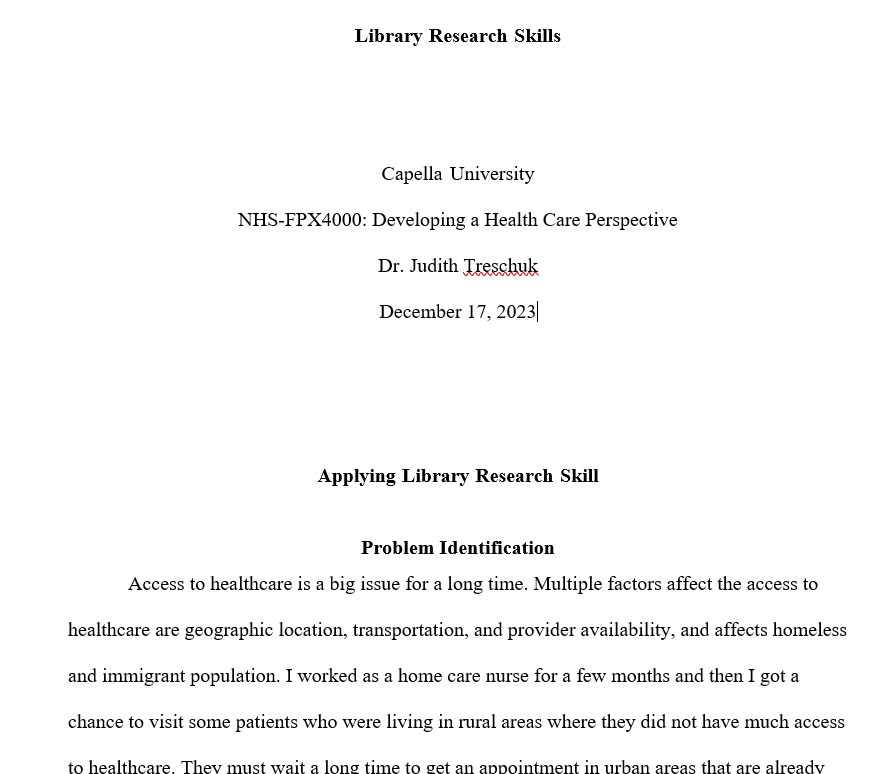Capella University
NHS-FPX4000: Developing a Health Care Perspective
Dr. Judith Treschuk
December 17, 2023
Applying Library Research Skill
Problem Identification
Access to healthcare is a big issue for a long time. Multiple factors affect the access to healthcare are geographic location, transportation, and provider availability, and affects homeless and immigrant population. I worked as a home care nurse for a few months and then I got a chance to visit some patients who were living in rural areas where they did not have much access to healthcare. They must wait a long time to get an appointment in urban areas that are already booked with their local patients. Even for their basic appointments, they must plan for transportation. Sometimes in an emergency, their condition can worsen because of the distance they have to travel to get to the hospital. Homeless and immigrants also do not have access to healthcare because they do not have transportation and insurance coverage. Telehealth and online appointments have helped people who were unable to get healthcare access. Similarly, more insurance firms provide coverage for transportation so people can have access to healthcare. However, it is still challenging for some to access convenient services.
Identifying Academic Peer-Reviewed Journal Articles
Databases I used to access information included PubMed, summon, and Google. I refined my research to scholarly and peer-reviewed journals that were published in the last five years. I used key phrases geographic healthcare limitations, limited healthcare access in rural areas, healthcare access barriers, and access to healthcare in the USA.
Assessing Credibility and Relevance of Information Sources
The Currency, Relevance, Authority, Accuracy, and Purpose (CRAAP) provided insights into the best approaches for identifying credible sources. While researching creditable sources, it is necessary to include peer-reviewed journal articles published within 5 years. A second consideration was the alignment of findings with the topic on limited access to care. In this case, it is important to be comfortable with using the peer-reviewed articles for a research paper. Further, authoritative sources published by authors with the relevant credentials and qualifications enhance credibility of findings on limited access to care. Lastly, it was important to pay attention to the purpose of the articles to ensure that they adequately and comprehensively addressed the topic.
Annotated Bibliography
Mwase, K. B. (2022, October 26). An evaluation of a framework for supporting Ehealth
Service Delivery in a Ugandan rural setting. HIMSS. Retrieved December 6, 2022, from
https://www.himss.org/resources/evaluation-framework-supporting-ehealth-service-
delivery-ugandam-rural-setting
In this article research was done to evaluate how effective is health in a rural area by using three parameters- functionality, usability, and traceability. Studies revealed it was a usable method to find challenges in delivering services in rural areas. The quality of healthcare in the rural areas are often limited. In these rural areas, the challenges to healthcare quality are many, ranging from poor infrastructure, low literacy, and poverty, to inadequate monitoring of patients with chronic or serious diseases. The rationale for selecting the source is because it highlights challenges in rural areas that expose patients and families to limited access to health care. The findings on e-health suggest the need for alternatives and innovative ways of enhancing access to quality and safe care.
Chu, C., Cram, P., Pang, A., Stamenova, V., Tadrous, M., & Bhatia, R. S. (2021). Rural
telemedicine use before and during the COVID-19 pandemic: Repeated cross-sectional
study. Journal of Medical Internet Research, 23(4). https://doi.org/10.2196/26960
This article shows how Covid-19 has affected the increase in telemedicine. This article used the data from January 2012 to June 2020 to compare the changes in telemedicine among rural-urban areas. It has been a major challenge for patients in rural areas to have access of healthcare particularly for chronic disease management. Telemedicine helps time and cost of traveling, and Telemedicine usage was more in older adults during the pandemic in rural areas. Despite telemedicine’s effectiveness in a rural area, there are some other limitations that affect access to healthcare such as the availability of devices, internet connectivity, and knowledge about technology. The rationale for using the article is because it discusses challenges in accessing care based on events witnessed during the COVID-19 pandemic. In this case, it is easier for nurse researchers to visualize the role of telemedicine in strengthening access to quality and safe care.
Cyr, M. E., Etchin, A. G., Guthrie, B. J., & Benneyan, J. C. (2019). Access to specialty
healthcare in urban versus rural US populations: A systematic literature review. BMC
Health Services Research, 19(1). https://doi.org/10.1186/s12913-019-4815-5
This article is an attempt to find if living in urban and rural areas can put people at a disadvantage of healthcare accessibility. It also shows that even race and ethnicity plays a role in access to healthcare. The research was conducted from CINAHL, Medline, PubMed, PsycInfo, and ProQuest Social Sciences databases published between January 2013 and August 2018. This article found some more contributing factors to access to healthcare than just rural areas such as insurance policies, government, primary care, and specialty care, race, and ethnicity. The rationale for using the article is that it compares the situation in rural and urban areas. The comparison provides insights into the need for evidence-based efforts that will reduce disparities in rural areas.
Naylor, K. B., Tootoo, J., Yakusheva, O., Shipman, S. A., Bynum, J. P., & Davis, M. A. (2019).
Geographic variation in spatial accessibility of U.S. Healthcare Providers. PLOS ONE,
14(4). https://doi.org/10.1371/journal.pone.0215016
This article shows the distribution of physicians, the emergence of advanced practice providers and demographic population shifts contributed to a variation in healthcare access. They used a combination of medical claims, provider location, and census data to do a study of provider accessibility. They found that Midwest had higher access to family medicine physicians whereas urban locations had greater access to internal specialists. Nurse practitioners had similar access to family medicine physicians in rural areas. The rationale for using the source is because of the comprehensive evidence on health disparities across the United States. The findings allow researchers to make informed conclusions about sustainable interventions appropriate for strengthening access to quality and safe care.
Learnings from the Review of Journal Articles
The findings provided lessons on the different factors associated with limited access to care. The articles by Cyr et al. (2019) and Naylor et al. (2019) identified multiple factors behind disparities in accessing care. In this case, I learned that patients in rural areas are vulnerable to long distances from the nearest hospital, limited information and communication infrastructure, inadequate healthcare staffing, and low literacy levels that undermine access to quality and safe care. The lessons from Mwase (2022) also revealed challenges such as uninsured or underinsured individuals, few specialty physicians, and unreliable Internet connectivity that jeopardizes access to evidence-based and patient-centered care. The lessons provide insights into the need for tailored and sustainable interventions to address holistic needs of patients in remote locations or regions experiencing persistent disparities.
References
Ali Mwase, K. B. (2022, October 26). An evaluation of a framework for supporting E-health
service delivery in a Ugandan rural setting. HIMSS.
https://www.himss.org/resources/evaluation-framework-supporting-ehealth-service-
delivery-ugandan-rural-setting
Cyr, M. E., Etchin, A. G., Guthrie, B. J., & Benneyan, J. C. (2019). Access to specialty
healthcare in urban versus rural US populations: A systematic literature review. BMC
Health Services Research, 19(1). https://doi.org/10.1186/s12913-019-4815-5
Chu, C., Cram, P., Pang, A., Stamenova, V., Tadrous, M., & Bhatia, R. S. (2021). Rural
telemedicine use before and during the COVID-19 pandemic: Repeated cross-sectional
study. Journal of Medical Internet Research, 23(4). https://doi.org/10.2196/26960
Naylor, K. B., Tootoo, J., Yakusheva, O., Shipman, S. A., Bynum, J. P., & Davis, M. A. (2019).
Geographic variation in spatial accessibility of U.S. Healthcare Providers. PLOS ONE,



